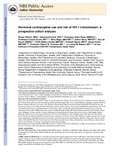Browsing Faculty of Arts & Social Sciences (FoA&SS / FoL / FBM) by Author "Rees, H"
Now showing items 1-3 of 3
-
Contraceptive method and pregnancy incidence among women in HIV-1-serodiscordant partnerships.
Ngure, K; Heffron, R; Mugo, NR; Celum, C; Cohen, CR; Odoyo, J; Rees, H; Kiarie, JN; Were, E; Baeten, JM (Obstetrics and Gynaecology, Kenyatta National Hospital, Nairobi, Kenya., 2012)Background: Effective contraception reduces unintended pregnancies and is a central strategy to reduce vertical HIV-1 transmission for HIV-1-infected women. METHODS: Among 2269 HIV-1-seropositive and 1085-seronegative ... -
Hormonal contraceptive use and risk of HIV-1 disease progression.
Heffron, R; Mugo, N; Ngure, K; Celum, C; Donnell, D; Were, E; Rees, H; Kiarie, J; Baeten, J; Bukusi, EA (Epidemiology, University of Washington, Seattle, Washington 98104, USA., 2013)BACKGROUND: For HIV-1-infected women, hormonal contraception prevents unintended pregnancy, excess maternal morbidity, and vertical HIV-1 transmission. Hormonal contraceptives are widely used but their effects on HIV-1 ... -
Use of hormonal contraceptives and risk of HIV-1 transmission: a prospective cohort study.
Heffron, R; Donnell, D; Rees, H; Celum, C; Mugo N, de Bruyn G, Nakku-Joloba E Were E; Ngure K, Coombs RW, Baeten JM Kiarie J, (Epidemiology, University of Washington, Seattle, WA, USA., 2012)Hormonal contraceptives are used widely but their effects on HIV-1 risk are unclear. We aimed to assess the association between hormonal contraceptive use and risk of HIV-1 acquisition by women and HIV-1 transmission from ...



